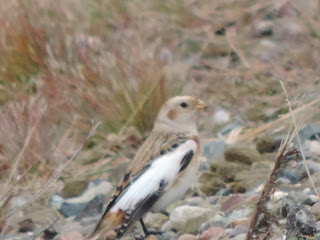NATURE
MONCTON INFORMATION LINE, November 2, 2018 (Friday)
Please advise editor at nelsonpoirier435@gmail.com if any errors are noted in wording or
photo labeling.
For more information on Nature Moncton, check into the website at www.naturemoncton.com
For more information on Nature Moncton, check into the website at www.naturemoncton.com
Transcript by: Louise Nichols nicholsl@eastlink.ca
To respond by e-mail, please address
your message to the information line editor nelsonpoirier435@gmail.com.
** The BOHEMIAN WAXWINGS [Jaseur boréal] have arrived in Moncton. Gabriel Gallant paid a visit to Bell Marsh on
Thursday to find a large group of Bohemian Waxwings and AMERICAN ROBINS [Merle
d'Amérique] foraging
on berries on either side of the trail.
Later in the day, Gabriel comments, he flushed a WILSON'S SNIPE [Bécassine
de Wilson] while
walking across a field near his Sainte-Marie-de-Kent home.
** Jean Renton is spending these weeks
at their Canaan area camp and making lots of nature observations. They have a large BLACK BEAR [Ours noir] that is seen regularly. Jean comments that it seems plump-ready for
the winter as she notes its back area jiggling as it runs off. They’re also seeing a doe WHITE-TAILED DEER [Cerf
de Virginie]
and a fawn regularly, but no bucks as yet.
Jean also comments on finding a new mushroom that she has not found
before – the CHICKEN MUSHROOM. This
mushroom grows in overlapping clusters of shelves on trees, but the top of the
mushroom shelves are smooth orangey-red to yellow-orange caps with sulphur-yellow
pores underside. It is considered a
choice edible when fresh, but Jean comments she has had better.
** Any bird species has potential to
become a partial albino. Aldo Dorio got
a photo of a partial albino SNOW BUNTING [Bruant des neiges] on Thursday at Hay Island. Unfortunately, it appeared injured with one
wing drooping and seemingly not able to fly.
** This week’s Sky-at-a-Glance is included in this
edition, courtesy of sky-guru Curt Nason.
Note Curt’s comment about reverting to standard time at 2:00 AM this
coming Sunday morning, “gaining an extra hour of evening observing”. Only a sky-watcher would express that thought
about losing an hour of daylight with the sun setting one hour earlier.
This
Week’s Sky at a Glance, November 3 – November 10
Deep sky objects are often called faint fuzzies by amateur astronomers, but many are bright enough to be seen with binoculars. Since we are about halfway through autumn let’s start by using the constellation Pegasus as a guidepost. The southwest corner of the square (or diamond) is the base of the winged horse’s neck, and moving away from the square by a couple of stars takes us to the horse’s eye. Extending that line by the distance from the middle of the neck to the eye is where you will find a small blurry patch called M2, a globular cluster that is the second entry in the Messier list of deep sky objects. Angling to the left at the eye we come to a star at the horse’s snout, and extending by nearly half that distance is a larger globular cluster, M15.
The star at the northeast corner of the square is Alpheratz, the brightest star of Andromeda, from which spread two lines of stars. The second star away from Alpheratz along the brighter string is orange Mirach, and moving up two stars from there we encounter the large Andromeda Galaxy, M31. From a dark sky you might notice a fat star and a subtle hazy patch close by, They are M32 and M110, satellite galaxies of M31. In the opposite direction from Mirach and at about the same distance as M31 is fainter M33, the third largest galaxy in our Local Group behind Andromeda and the Milky Way. We see M33 face on, which makes it appear dimmer.
The third brightest star of Andromeda is the double star Almach, situated at the end of the string from Mirach. Look in the area halfway between Almach and Algol, the second brightest star in Perseus, for the open cluster of stars called M34. Next, look above Andromeda for the familiar W-shape of Cassiopeia. A line from the bottom right star of the W to the top right and extended the same distance brings us to open cluster M52. Now go outside and locate them.
This Week in the Solar System
Saturday’s sunrise in Moncton is at 8:02 am and sunset will occur at 6:02 pm, giving 10 hours of daylight (8:06 am and 6:06 pm in Saint John). Next Saturday the Sun will rise at 7:12 am and set at 4:52 pm, giving 9 hours, 40 minutes of daylight (7:15 am and 5:00 pm in Saint John). We revert to Standard Time at 2 am Sunday, gaining an extra hour of evening observing.
The Moon is new on Wednesday, giving darker skies for teasing deep sky objects out of the background stars. Mercury is at greatest elongation from the Sun on Tuesday, with Jupiter about two binocular widths to its right and a tad higher. You might need binoculars to see them, Mercury especially. Mars is highest in the sky around 7 pm while Saturn sets around 8 pm. Early risers or late-night revellers might notice an occasional shooting star coming from Taurus on Monday as that is the peak of the minor South Taurid meteor shower.
The Saint John Astronomy Club meets in the Rockwood Park Interpretation Centre this Saturday at 7 pm. All are welcome.
Questions? Contact Curt Nason at nasonc@nbnet.nb.ca.
Nelson Poirier,
Nature Moncton
Autumn DSOs
BOHEMIAN WAXWING. NOV 1, 2018. GABRIEL GALLANT
SNOW BUNTING (PARTIAL ALBINO). NOV 1, 2018. ALDO DORIO


